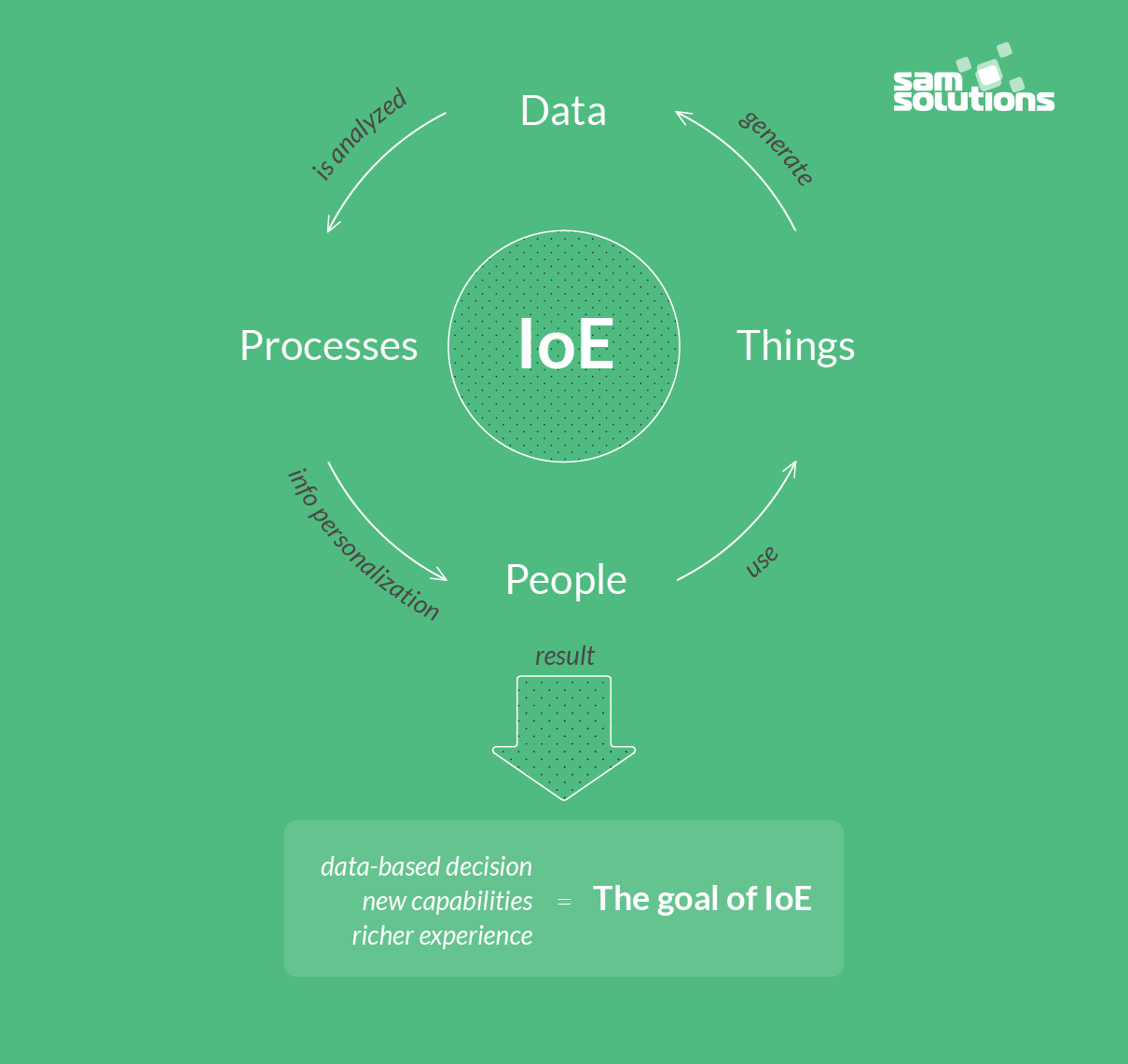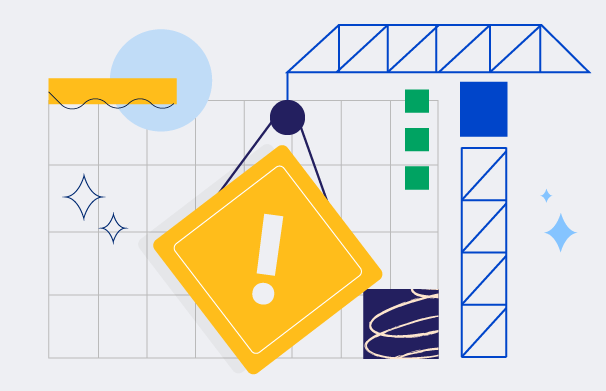The evolution of the global web has resulted in virtual connections ubiquitously penetrating real-world objects and activities. Today, everything can be connected with everything, creating a new distributed ecosystem that goes beyond the familiar IoT (Internet of Things) concept. Cisco has coined a special term — the Internet of Everything (IoE) — to describe this dynamically changing phenomenon. In this article, we will formulate the Internet of Everything definition and how it differs from the IoT.
We provide leading-edge IoT development services for companies that want to transform their business
Internet for Everything: Definition and Main Features
The IoE concept is based on the idea of all-round connectivity, intelligence and cognition. It means that intelligent internet connections are not restricted by computers, tablets and smartphones (as used to be the case for the last couple of decades). Any object can be outfitted with digital features and connected to the common network of other objects, people and processes in order to generate valuable information, exchange it and facilitate relevant decision-making.
What Is IoE?
So, what is the Internet of Everything in simple terms? The Internet of Everything is the connections between people, things, data and processes combined into a common interrelated system, the aim of which is to improve experiences and make smarter decisions.
The IoE philosophy depicts the world in which billions of sensors are implanted into billions of devices, machines and ordinary objects, giving them expanded networking opportunities, thus making them smarter.
What does IoE mean for businesses, governments and individuals? The main goal of the IoE technology is to convert collected information into actions, facilitate data-based decision-making and provide new capabilities and richer experiences.
Read also: The Role of IoT in Smart Manufacturing

IoE Features
- Decentralization and moving to the edge — data is processed not in a single center, but in numerous distributed nodes
- Data input and output — external data can be put into devices and given back to other components of the network
- Relation to every technology in the process of digital transformation — cloud computing, fog computing, AI, ML, IoT, Big Data, etc. Actually, a rise in Big Data and the IoE technology development are interconnected
IoE Constituent Elements
Key components of the IoE market are hardware, software and services. As for constituent elements of the Internet of Everything, there are four of them:
People
People provide their personal insights via websites, applications or connected devices they use (such as social networks, healthcare sensors and fitness trackers); AI algorithms and other smart technologies analyze this data to “understand” human issues and deliver relevant content according to their personal or business needs that helps them quickly solve issues or make decisions.
Things
Here we encounter the pure IoT concept. Various physical items embedded with sensors and actuators generate data on their status and send it to the needed destination across the network.
Data
The raw data generated by devices has no value. But once it is summarized, classified and analyzed, it turns into priceless information that can control various systems and empower intelligent solutions.
Processes
Different processes based on artificial intelligence, machine learning, social networks or other technologies ensure that the right information is sent to the right person at the right time. The goal of processes is to guarantee the best possible usage of Big Data.
Internet of Everything vs. Internet of Things
To avoid the confusion between the terms, IoT vs. IoE, let’s figure out in what ways they differ.
The core difference between the Internet of Things and the Internet of Everything is the number of pillars for these concepts:
- IoT focuses on physical objects only
- IoE encompasses four components (things, processes, data and people)
The IoT, in essence, is the interconnectivity of physical objects that send and receive data, while the IoE is a wider term that includes, apart from IoT, numerous technologies and people as the end-nodes.
Although IoT and IoE are different terms, there are also some similarities between them:
- Decentralization — both systems are distributed and don’t have a single center; each node works as a small management center and is able to perform certain tasks independently
- Security issues — distributed systems are still highly vulnerable to penetration and cyberattacks; the more devices are connected to the network, the higher the susceptibility to breaches
On the one hand, decentralization is one of the IoE and IoT advantages, since the whole system doesn’t fail even if there are problems in a couple of nodes. On the other has, such a distribution causes disadvantages in the form of threats for data security and personal privacy.
Internet of Everything Examples
Practically every industry can apply the Internet of Everything model into its processes and benefit from it. Here are some general examples:
- Municipality systems can implement smart water and electricity meters for residents and commercial organizations in order to monitor usage rates and make decisions concerning economy and cutting costs.
- The manufacturing industry can implement sensors for predictive maintenance into production to monitor equipment parts that need to be fixed or replaced. This helps eliminate downtime and reduce the fixing costs.
- Logistics and delivery companies can introduce sensors and smart devices on trucks to optimize delivery conditions and possible routing. Eventually, companies can improve end-user satisfaction.
Closing Thoughts
Overall, digitalization facilitates the creation of millions of intelligent and automated hardware pieces. The range of IoE appliances is growing, and industries are inevitably changing.
We are definitely going to see the future of ubiquitous connectivity. It will not dramatically change the way we do business, but it will help us provide better services and create better products.
We develop world-class IoT solutions for SMBs and enterprises
SaM Solutions has versatile experience in embedded software development. We create solutions of various types, from server monitoring and diagnostic suites to custom kernels, bootloaders and applications.
In partnership with Toradex, our specialists have developed a prototype of a predictive maintenance system that analyzes the state of an electric motor. You can watch the record of our webinar on this topic, or consult a specialist to learn more.



























 5 Reasons Why Your Business Needs a Mobile eCommerce Application
5 Reasons Why Your Business Needs a Mobile eCommerce Application Using Salesforce to Improve Your Sales Pipeline: Five Tips
Using Salesforce to Improve Your Sales Pipeline: Five Tips Cross-Platform Mobile Development: Five Best Frameworks
Cross-Platform Mobile Development: Five Best Frameworks How to Develop Custom Accounting Software
How to Develop Custom Accounting Software 10 Best Web Development Frameworks in 2024
10 Best Web Development Frameworks in 2024












 Top 30 Ecommerce Tools to Elevate Your Business in 2024
Top 30 Ecommerce Tools to Elevate Your Business in 2024 5 Best Tools to Improve Embedded Software Testing
5 Best Tools to Improve Embedded Software Testing Why React and Node.js Are the Top Technologies for Creating High-Performance Web Apps in 2024
Why React and Node.js Are the Top Technologies for Creating High-Performance Web Apps in 2024 10 Best IoT Platforms for 2024
10 Best IoT Platforms for 2024
Hello, Natalia! Thank you for such an insightful article. I have also conducted a research on IoE technology and i would like to add that IoE wil greatly influence our lives. It is the technology of future enabling to build and deploy unique solutions, turning the performance of industries upside down and streamlining the businesses in the needed direction. It may also have a tremendous impact on the lives of the people with disabilities making them more autonomous.
Hi Nadiia! Thanks for your feedback and comment on the topic. I completely agree that IoE will reshape many industries and spheres in the near future.
Hello, I am struggling with a university Question. Describe the architecture of TCP / IP model including each layers’ function.
Application layer
Transport layer
Network layer
Phys / Link layer
You make things so simple. How would you answer this?